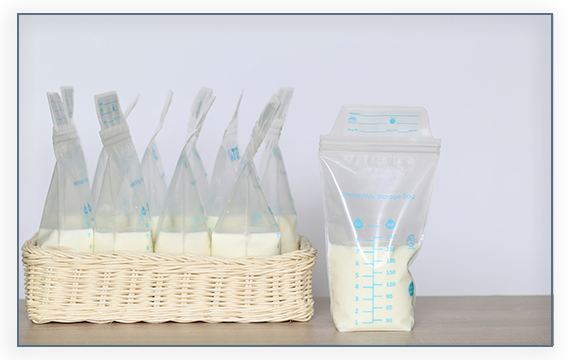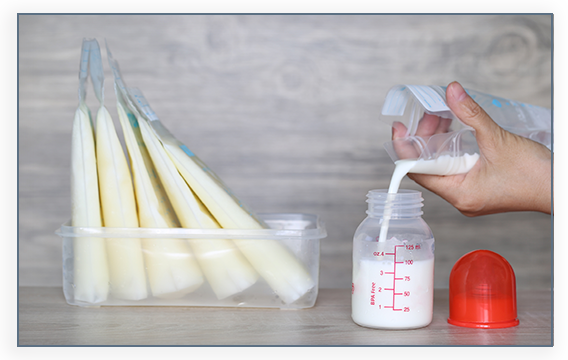Breastfeeding Positions
There are many different positions that can work while breastfeeding. It is important to find one that is comfortable for both you and your baby. This will make feedings more enjoyable and successful! During the early weeks you and your baby will navigate and find what works best for you. There are several different positions you can try. You can use the tips below as a guide and modify to fit your needs. If you feel pain or discomfort, try a different position (also consider proper latch).


Cradle hold
This position is often used after your baby is a few weeks old and you are more confident in your breastfeeding hold.
• Your baby lays across your front at breast level with his/her tummy toward your chest. The whole front of his/her body should touch the front of your body.
• Your baby’s head will be resting in the crook of your elbow, on the same side you will be nursing from.
• Use pillows to lift your baby and support your elbows in order to bring your baby up to nipple height, especially during the first few weeks.
• Support your breast with either the “U” hold or “C” hold. You will support your breast using the opposite hand (if you are nursing on the left breast, use your right hand to support your breast).
• Your baby’s head will be on your forearm and his/her back will be along your inner arm and palm. When you look down, you should see his/her side.
• Your baby’s mouth should be covering at least a half inch of the dark area around your nipple.
• Your baby’s ear, shoulder and hips should be in a straight line. As a newborn, your baby’s head and bottom should be level with each other.
Cross cradle
During the early weeks, many mothers find this variation of the cradle hold to be useful.
• Use a pillow to support your baby across your lap, to help raise him/her to your nipple level.
• Pillows should also support both elbows so your arms don’t hold the weight of the baby (your arms will tire before the feeding is finished).
• If you are nursing on the left breast, your left hand supports that breast in a “U” hold. If you are breastfeeding on the opposite breast, reverse the hand used. Support your baby with the fingers of the opposite hand.
• To support baby, gently place your hand behind your baby’s ears and neck with your thumb and index finger behind each ear. The palm of your hand is placed between baby’s shoulder blades.
• When baby opens his/her mouth wide, push with the palm of your hand from between the shoulder blades. His/her mouth will be covering at least a half-inch from the base of your nipple.
Have more questions? Listen to our FREE podcast!
LISTEN NOWFootball hold/Clutch position
This hold is really great for a mom who had a c-section. It is also useful for women with large breasts, or those who have a forceful let down. This position allows baby to handle a faster flow. Most newborns are very comfortable in this position.
• In this position you support your baby’s head in your hand and his/her back along your arm beside you. Your baby will lay along your side under your arm with your hand supporting the back of the baby’s neck.
• Support your breast with a “C” hold.
• The baby’s bottom should bump up against whatever you are sitting in (back of the chair, couch, etc.) Make sure to bend the baby’s legs at the hip (feet pointing toward the ceiling), so that he/she does not push his her feet against whatever you’re leaning against.
• Use pillows help bring the baby to the correct height (nipple level).
Side lying
For some moms this position works best after the early days of breastfeeding. The other positions may be easier to learn first. Some moms find that practicing with this position during the daytime is very helpful.
• Both mother and baby lie on their sides facing each other.
• You can use pillows behind your back and behind or between your knees to help get comfortable. A pillow or rolled blanket behind the baby’s back will keep him from rolling away from you.
• Your baby’s nose should be in line with your nipple.
• Baby’s hips should be flexed and their ear, shoulder and hip should be in one line. This helps your baby get milk more easily.
Laid back
This position can be helpful for newborns, gassy babies, moms with smaller breasts, and nighttime feedings (as long as you don’t fall asleep). Lean back on a couch or in bed and prop your back up with pillows. Position your baby on top of you, tummy-to-tummy. Your baby’s body can be in any direction, as long as his/her mouth is at your nipple. From there, your baby can usually latch on naturally, or you can direct your breast to baby’s mouth.
The information contained here within is not intended to be a substitute for professional medical advice, diagnosis, or treatment. Always seek the advice of your physician or other qualified health provider with any questions you may have regarding a medical condition. Never disregard professional medical advice or delay in seeking it because of something you have read. If you think you may have a medical emergency, call your doctor, go to the emergency department, or call 911 immediately. Edwards Health Care Services (EHCS) does not recommend or endorse any specific tests, physicians, products, procedures, opinions, or other information that may be mentioned here within. Reliance on any information provided by EHCS, EHCS employees, contracted writers, or medical professionals presenting content for publication here within is solely at your own risk.
Sources:
• American Pregnancy Association: https://americanpregnancy.org/breastfeeding/latch/
• La Leche League: https://www.llli.org/breastfeeding-info/positioning/
• What to Expect: https://www.whattoexpect.com/first-year/photo-gallery/breastfeeding-positions/
Tags: Baby, Breastfeeding, Feeding, Infant, Latch, Mom, Newborn




